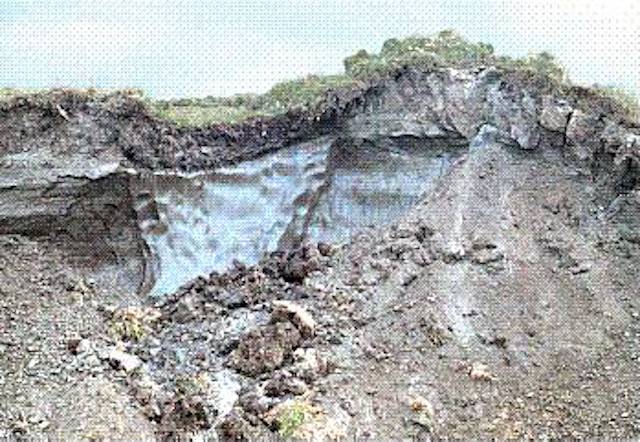Ice covers roughly 10 percent of our planet’s surface. It is a harsh and unforgiving element, one that even today proves a challenge for the men and women who try to master and overcome it.
But at the same time, ice is a really useful medium when it comes to preserving things as they were decades, centuries, even millennia ago. Glacial archaeology is a relatively new field, but one that has uncovered a lot of unexpected discoveries as more and more glaciers recede and reveal the secrets they’ve been hiding.
10. Ancient Viruses

Back in 2015, a team of microbiologists and climatologists from Ohio State University traveled to the frozen wilderness of the Tibetan plateau in search of some ancient ice. They had developed a new method of studying it without worrying about contamination, and they were curious to see what information the ice could provide about the environment from thousands of years ago.
The scientists traveled to the summit of the Guliya ice cap, 22,000 feet above sea level, and dug out a core that was over 1,000 feet deep. Inside they found viruses…lots of them…that have been frozen in ice for 15,000 years.
That single ice core contained genetic material belonging to 33 different types of viruses, 28 of which were completely new to science. The Ohio team believed that none of the microbes were harmful to humans, but they cannot say the same thing for all the other countless viruses currently on ice. And with glaciers melting due to climate change, they believe that harmful ancient pathogens making their way into the modern world becomes a dangerous possibility.
9. Very, Very Old Seeds

Don’t worry. It’s not all doom and gloom, though, because there are also some nice things waiting in the permafrost for us to discover them, such as the oldest seeds ever used to actually grow a plant.
The story might sound like something out of the Ice Age movies, but around 32,000 years ago, an ancient squirrel was getting ready for hibernation and had collected a cache of seeds of the Siberian plant Silene stenophylla. Then, the squirrel’s entire burrow was buried under snow and became permanently encased in ice for thousands of years. That is…until a few years ago when it was discovered by Russian scientists from the Institute of Cell Biophysics.
While studying the frozen seeds, the scientists noticed that some of them still contained viable plant material, so they wanted to see if they could grow plants from 32,000-year-old seeds. Keep in mind, at the time, the world record for the oldest plant material brought to life was just 2,000 years old, but they were successful in bringing back an ancient variant of Silene stenophylla which was similar to the modern plant, except for the shape of the flower.
8. Yuka the Mammoth
Ice has been great at preserving not just plant life and viruses, but also animals. There is, at the moment, a strong drive among scientists to use remains found frozen in ice to bring back extinct creatures, and the one that’s getting the most attention is none other than the woolly mammoth.
Mammoths only went extinct a few thousand years ago and, since then, we have recovered quite a few specimens that had been frozen in ice. The title of “best-preserved mammoth” goes to Yuka, a baby that was found by Siberian hunters back in 2010. Although originally estimated to be 39,000 years old, the age was brought down a bit to 28,000 following more tests, but it’s the condition that scientists were interested in, not the age. Yuka had been killed by ancient hunters who removed most of the internal organs and some of the bones. They then left the rest of the carcass intact and presumably buried it to retrieve it later, but never did.
Their loss was our gain, as Japanese scientists were able to extract tissue samples from the muscles and bone marrow. More notable, they were then able to implant cell nuclei from those samples into egg cells taken from mice, which then showed some form of biological activity. In other words, scientists reawakened 30,000-year-old mammoth cells. Although the activity was very faint, the Japanese team called it a “significant step toward bringing mammoths back from the dead.”
7. The Remnants of a War

During the First World War, there were two armies that were involved in their own special conflict, unlike any others. The Italians and the Austrians were fighting each other high in the Alps, mainly on the frozen glaciers of the Dolomite Mountains, in what became known as the White War.
Oftentimes, the soldiers dug tunnels in the ice. The Austrian Corps of Engineers even dug an entire base, with multiple barracks and passageways, under Marmolada Glacier. Once the war was over, everything was abandoned. The only ones who still risked venturing out there were salvagers, but they were interested in scrap metal, not artifacts or documents. Once even they stopped showing up, nature soon reclaimed the area and buried everything under ice.
That’s how things stayed for almost a hundred years. But as the glaciers began to melt, they slowly exposed everything again, and people could see a war that was frozen in time for a century. They recovered guns, cannons, supplies, food, letters, diaries, photographs, and, of course, bodies. Particularly striking were the well-preserved frozen remains of two young Austrian soldiers – both of them teenagers with blond hair and blue eyes, and both with bullet holes in the head.
6. The Solution to a Mystery
Sometimes, discoveries made in the ice can provide answers to decades-old mysteries, such as the curious disappearance of Marcelin and Francine Dumoulin, who vanished without a trace almost 80 years ago.
On August 15, 1942, the Swiss couple left their home on foot and never returned. Local lore says that the two went out to milk their cows, although they might have been traveling to Bern. Either way, nobody had any clue what had happened to them despite search parties going out for months following their disappearance. Then, in 2017, the mystery was solved when a ski resort worker found their mummified remains buried in ice.
The bodies were found on the Tsanfleuron glacier, over 8,500 feet above sea level. They were dressed in World War II-era clothes so, right off the bat, it became pretty clear that they had been on ice for a long time, and DNA tests subsequently confirmed their identities as the Dumoulins.
The most likely scenario is that the married couple fell into a crevasse, which then became their icy tomb for decades. Then, due to climate change, the glacier receded, finally causing their bodies to emerge to the surface.
5. Treasure

We’ve all heard of buried treasure, but we don’t usually expect to find it buried in ice thousands of feet above sea level. And yet that is exactly what happened in 2013 when a French mountain climber stumbled upon a curious metal box poking out of the ice as he was crossing Bosson glacier on his way to the summit of Mont Blanc. Inside the box, he found emeralds, rubies, and sapphires worth around 250,000 euros, that had been sitting there for almost half a century.
The spot is infamous as the location of not one, but two separate crashes involving Air India flights, which caused the deaths of 165 people – the first one in 1950 and the second in 1966. The latter was a large passenger flight aboard a Boeing 707 which crashed right into the mountain and caused debris to spread all over the place. Very bad weather delayed the initial recovery efforts so, by the time rescuers reached the crash site, many items had already been buried under snow.
That was likely what happened with the box of jewels which almost certainly was aboard the doomed flight from 1966. The mountain climber did not try to keep the treasure and, instead, surrendered it to the authorities, which triggered a legal battle over who was the rightful owner of the precious gems.
4. A Primordial Lake
If there is one thing you probably would not expect to find under ice, that would be liquid water. But as it turns out, that’s not necessarily true. All the way back in the 19th century, scientists have speculated that liquid freshwater might exist under the Antarctic Ice Sheet. Due to geothermal heating, they argued that the temperature beneath the ice sheets could be high enough to melt the ice and form what we now call subglacial lakes.
It wasn’t until the 1970s that the existence of these lakes was confirmed using ice-penetrating radar, and it wasn’t until the 90s that we discovered the largest subglacial lake in the world – Lake Vostok, located in the center of the East Antarctic Ice Sheet. But just because we knew it was there didn’t mean we could actually reach it. Vostok was buried under two miles of ice and it wasn’t until 2013 that Russian scientists managed to drill through it and obtain an ice core.
Up until that point, Lake Vostok had been sealed off from the rest of the world for 15 million years, so nobody really knew what to expect to find in it. The Russian scientists boldly proclaimed to have discovered unrecognizable bacteria, completely new to science, but they later backtracked after their samples had been contaminated with drilling fluid. Lake Vostok is still teeming with life, although none of it is as “otherworldly” as people were hoping.
3. The Children of the Inca

Arguably, the most disturbing frozen discovery ever made occurred in 1999, when a team of archaeologists reached the summit of Mount Llullaillaco on the border between Argentina and Chile. Inside an icy tomb, they found signs of one of humanity’s most blood-curdling practices – human sacrifices. Not just one, but three children had been placed inside a small chamber where they were left to freeze to death, unintentionally becoming the most well-preserved ice mummies ever recovered.
The juveniles had been sacrificed around 500 years ago by the Inca. They consisted of two young children, a boy and a girl, who were both around six years old when they died, and a teenage girl, who became known as La Doncella or The Maiden. Tests showed that the three children were given a special diet in the months leading up to their sacrifice, which included coca leaves and a corn beer called chicha. Their consumption of both skyrocketed during the last weeks of their lives, so it seems that the kids were kept in a state of almost constant inebriation in the time leading up to their deaths.
2. Millions of Grasshoppers

One of the most interesting and unique glaciers in the world can be found in the Beartooth Mountains of Montana. It is called Grasshopper Glacier and its name comes from the tens of millions of grasshoppers that have become embedded in the ice. Most of them have been there for centuries and they include at least one species called the Rocky Mountain locust which has been extinct for over a hundred years.
Scientists are pretty sure that the insects were traveling in swarms when they encountered heavy blizzards. They then perished on top of the glacier and became trapped in the ice.
Located in a very remote area of Custer National Forest 11,000 feet above sea level, Grasshopper Glacier wasn’t even discovered until the early 1900s. Since then, it has shrunk considerably due to climate change which has caused a lot of the frozen grasshoppers to thaw and decompose.
1. Otzi the Iceman
We end this list with a look at the most famous human ever found encased in ice: Otzi the Iceman.
Discovered in 1991 in the Ötztal Alps on the border between Italy and Austria by two German tourists, Otzi was the ice mummy of a man who lived more than 5,300 years ago, during the Copper Age. He was trying to traverse the snowy mountains when he was attacked and shot with an arrow. Presumably, he then died of blood loss and remained remarkably well-preserved in the ice for thousands of years. Alongside him, scientists also recovered all the items that Otzi had on him, including his clothes, tools, and weapons. His most impressive possession was an exquisite ax which was made out of 99.7 percent pure copper, a rare and incredibly valuable item in his time.
In the 30 years since his discovery, Otzi had been studied in-depth, yet we are still learning new things about him and the people of the Copper Age thanks to his mummy. And if you would like to learn more about him, we’ve done a full-length video on Otzi the Iceman on our sister channel, Biographics. Why not check it out?